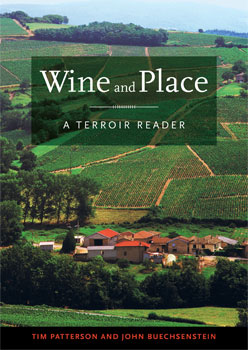

Wine and Place: A Terroir Reader
Author: Tim Patterson and John Buechsenstein
Publisher: University of California Press
Price: $39.95
In Wine and Place, authors John Buechsenstein and Tim Patterson are on a mission to rescue terroir. “The concept of terroir needs a good housekeeping in order to defend it,” they state. “As long as the concept is overgrown with mythology, as long as crucial aspects of it go untended, as long as it is allowed to mean anything to anybody, we believe that terroir will be vulnerable to exploitation by marketing departments happy to claim whatever appeals to consumers or reinforces a branding initiative.”
This book is a reader, a collection of some of the most significant writing on terroir, expertly curated and connected by commentary. The concept for the book arose in 2008 when Buechsenstein, a winemaker, and Patterson, a writer, met at a conference in Portland, Oregon, and began to discuss terroir. The project was near completion when Patterson died in 2014, and Patrick Comiskey, a writer for this magazine and the LA Times, stepped in to finish it. The result is the most complete exploration of the topic of terroir to date.
Terroir is an important and interesting concept, but it’s also a complicated one. Without a clear definition, the term means different things to different people. And it operates on different scales: from whole countries, dialing down to regions, subregions, vineyards and even blocks within the same vineyard. At its most simple, wines made the same way from the same variety but from different sites often taste different.
In this sense, terroir is undeniable. Yet one thing we are lacking is proper research on the topic. What is the role of soil composition? How do site differences affect grapevine physiology in such a way that grape composition is changed? Is soil chemistry important, or are its physical properties, such as water-holding capacity, the key factors in terroir? Some of the texts included here begin to address this, most notably Seguin’s famous study on the terroirs of Bordeaux, and lead the reader towards the view that a soil’s physical properties are key, but the intriguing possibility remains that soil chemistry matters, too.
Chapter one sets the scene, and chapter two explores the history of terroir. Then the book looks at soil, followed by a delve into climate. The influence of winemaking is dissected, followed by a chapter on sensory aspects: how we taste terroir. Finally, there are chapters on marketing and the future of the concept. It’s a nice, logical sequence.
Most of the texts are quoted in short, selected segments, something that helps with the flow of the book. I was particularly impressed by chapter three, focusing on soils. This is a difficult subject, and the authors correctly state that much work has gone into describing the physical structure of vineyard soils, but very few researchers have begun to make the link between soil composition and wine quality. They seek out the few that have investigated the topic, such as the famous soil researchers Claude and Lydia Bourguignon, who believe that great red wines can only come from limestone soils, and who state, “The United States has very little limestone, and its wine-makers would be well advised to concentrate on producing great white wines.” This is a provocative, controversial statement that I disagree with, but it’s indicative of the nature of this book that the authors don’t shy away from including controversial statements that provoke thought.
I also really enjoyed chapter five, which considers grapevine physiology. How is it that the grapevine can be a transmitter of terroir? This examines plant biology in some detail, and includes an essay from University of California Davis professor Mark Matthews, who sets out to debunk some of the myths surrounding the subject. I can’t think of any other book that has explored the subject in such a multidisciplinary way, or at the same sort of level. Wine and Place is honest, smart and non-partisan, and in a very adult way allows readers to form their own opinions on the topic. As such, it’s a great addition to the wine literature.
Based in London, Jamie Goode is a lapsed scientist who now devotes his time to writing about wine, mainly in the UK national newspaper the Sunday Express, and on his own site, wineanorak.com. The author of The Science of Wine (UC Press 2014) and I Taste Red (2016).
This story appears in the print issue of April 2018.
Like what you read? Subscribe today.
















